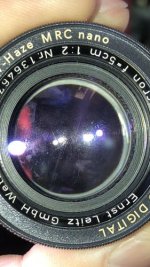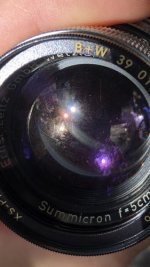B
bert26
Guest
I bought this collapsible summicron about a month ago for pretty cheap, the only issue was that the aperture ring needed to be loosened and there was very slight haze. There were a few TINY scratches that were hardly noticeable.
Well, I dropped it off to get it CLA'd and a month later I get back and it looks this.
I was in a hurry leaving the repair shop and just got home to look at it. You'd never notice just by glancing at it but holy **** when you look up close. I didn't think I'd need to mention that the lens has soft elements to a reputable repair shop.
I'm sure the shop will deny all this up and down and I didn't take a before photo. Anyway, is thing even worth using or should I cut my losses? I don't have a ton of time to shoot anymore and when I am out walking around I'm shooting difficult street pictures and don't wanna waste my time with a piece of **** lens. Sucks sucks sucks.
Well, I dropped it off to get it CLA'd and a month later I get back and it looks this.
I was in a hurry leaving the repair shop and just got home to look at it. You'd never notice just by glancing at it but holy **** when you look up close. I didn't think I'd need to mention that the lens has soft elements to a reputable repair shop.
I'm sure the shop will deny all this up and down and I didn't take a before photo. Anyway, is thing even worth using or should I cut my losses? I don't have a ton of time to shoot anymore and when I am out walking around I'm shooting difficult street pictures and don't wanna waste my time with a piece of **** lens. Sucks sucks sucks.



